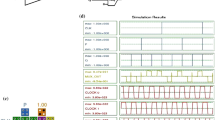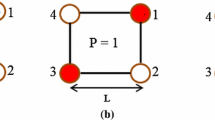Abstract
The Quantum-dot Cellular Automata (QCA) is the prominent paradigm of nanotechnology considered to continue the computation at deep sub-micron regime. The QCA realizations of several multilevel circuit of arithmetic logic unit have been introduced in the recent years. However, as high fan-in Binary to Gray (B2G) and Gray to Binary (G2B) Converters exist in the processor based architecture, no attention has been paid towards the QCA instantiation of the Gray Code Converters which are anticipated to be used in 8-bit, 16-bit, 32-bit or even more bit addressable machines of Gray Code Addressing schemes. In this work the two-input Layered T module is presented to exploit the operation of an Exclusive-OR Gate (namely LTEx module) as an elemental block. The “defect-tolerant analysis” of the two-input LTEx module has been analyzed to establish the scalability and reproducibility of the LTEx module in the complex circuits. The novel formulations exploiting the operability of the LTEx module have been proposed to instantiate area-delay efficient B2G and G2B Converters which can be exclusively used in Gray Code Addressing schemes. Moreover this work formulates the QCA design metrics such as O-Cost, Effective area, Delay and Cost α for the n-bit converter layouts.













Similar content being viewed by others
References
Lent, C., Tougaw, P., Porod, W., Bernstein, G.: Quantum cellular automata. Nanotechnology (1993) 4, 49–57 (1993). https://doi.org/10.1088/0957-4484/4/1/004
Tougaw, P., Lent, C.: Logical devices implemented using quantum cellular automata. J. Appl. Phys. 85, 1818–1825 (1994). https://doi.org/10.1063/1.356375
Lent, C., Tougaw, P.: A device architecture for computing with quantum dots. Proceedings of IEEE 85, 541–557 (1997). PII: S 0018-9219(97)02731-X
Walus, K., Vetteth, A., Jullien, G.A., Dimitrov, V.S.: RAM Design Using quantum-dot cellular automata. Proceedings of the Nanotechnology Conference and Trade Show 2, 160–163 (2003)
Frost, S., Rodrigues, A.F., Janiszewski, A.W., Raush, R.K., Kogge, P.M.: Memory in Motion: A study of storage structures in QCA, First Workshop on Non-Silicon Computing (2002)
Berzon, D., Fountain, T.J.: A memory design in QCA using the SQUARES formalism. In: Proceedings of 9th Great Lakes Symposium on VLSI, pp 166–169 (1999). https://doi.org/10.1109/GLSV.1999.757402
Heikalabad, S.R., Navin, A.H., Hosseinzadeh, M.: Content addressable memory cell in quantum-dot cellular automata. Microelectronics Engineering 163, 140–150 (2016). https://doi.org/10.1016/j.mee.2016.06.009
Moon, T.K.: Error Correction Coding: Mathematical Methods and Algorithms. Wiley, New York (2005). ISBN: 978-0-471-64800-0
Ahmed, F., Ahmed, P.Z., Mohiuddin Bhat, G.: Design and analysis of odd-even-parity generators and checkers using Quantum-dot Cellular Automata (QCA). In: 2nd International Conference on Computing for Sustainable Global Development (INDIACom), pp. 187–194 (2015)
Ilanchezhian, P., Parvathi, R.M.S.: Nanotechnology based Effective Design Approach for Code Converter Circuits using QCA. Int. J. Comput. Appl. 69, 1–5 (2013). ISSN: 0975-8887
Iqbal, J., Khanday, F.A., Shah, N.A.: Efficient quantum dot cellular automata (QCA) implementation of code converters. Communications in Information Science and Management Engineering 3, 504–515 (2013)
Waje, M.G., Dakhole, P.K.: Design and Simulation of New XOR Gate and Code Converters using Quantum Dot Cellular Automata with reduced number of wire crossings. IEEE International Conference on Circuit Power and Computing Technologies, pp. 1245–1250 (2014). https://doi.org/10.1109/ICCPCT.2014.7054942
Ahmed, F., Bhat, G.M.: Novel Code Converters Based on Quantum-dot Cellular Automata (QCA). International Journal of Science and Research 3, 364–371 (2014). Paper ID: 020131715
Beigh, M.R., Mustafa, M.: Design and simulation of efficient code converter circuits for Quantum-Dot cellular automata. Journal of Computation and Theoretical Nanoscience 11, 2564–2569 (2014). https://doi.org/10.1166/jctn.2014.3673
Ahmad, F., Md, G., Bhat, P.Z., Ahmad, H.A., Khan, R.: Farooq, design of N-Bit code converter using Quantum-Dot cellular automata (QCA), advanced science. Engineering and Medicine 7, 1–8 (2015). https://doi.org/10.1166/asem.2015.1677
Rao, N.G., Srikanth, P.C., Sharan, P.: A novel quantum dot cellular automata for 4-bit code converters. Optik-International Journal of Light Electron Optic, pp. 1–4 (2015). https://doi.org/10.1016/j.ijleo.2015.12.119
Islam, S., Abdullah-al Shafi, Md., Bahar, A.N.: Implementation of Binary to Gray Code Converters in Quantum Dot Cellular Automata. Journal of Today’s Ideas-Tomorrow’s Technologies 3, 145–160 (2015). https://doi.org/10.15415/jotitt.2015.32010
Karkaj, E.T., Heikalabad, S.R.: Binary to gray and gray to binary converter in quantum-dot cellular automata. Optik-International Journal of Light Electron Optic 130, 981–989 (2016) https://doi.org/10.1016/j.ijleo.2016.11.087
Abdullah-al Shafi, Md., Bahar, A.N.: Novel Binary to Gray Code Converters in QCA with Power Dissipation Analysis. International Journal of Multimedia and Ubiquitous Engineering 11, 379–396 (2016). https://doi.org/10.14257/ijmue.2016.11.8.38
Mukherjee, C., Sukla, S.S., Basu, S.S., Chakraborty, R., De, D., Layered, T.: Full Adder using Quantum-dot Cellular Automata. In: IEEE International Conference on Electronics, Computing and Communication Technologies, pp. 1–6 (2015). https://doi.org/10.1109/CONECCT.2015.7383867
QCADesigner, Available: www.atips.ca/projects/qcadesigner
Liu, M., Lent, C.S.: Bennett and Landauer clocking in quantum-dot cellular automata. In: 10th International Workshop on Computational Electronics, pp. 120–121 (2004). https://doi.org/10.1109/IWCSE.2004.1407356
Toth, G., Lent, C.S.: Quasi-adiabatic Switching for Metal-Island Quantum-dot Cellular Automata. J. Appl. Phys. 85, 2977–2984 (1999). https://doi.org/10.1063/1.369063
Lent, C.: Molecular electronics-bypassing the transistor paradigm. Science 288, 1597–1599 (2000). https://doi.org/10.1126/science.288.5471.1597
Imre, A., Csaba, G., Ji, L., Orlov, A., Bernstein, G.H., Porod, W.: Majority logic gate for magnetic quantum-dot cellular automata. Science 311, 205–208 (2006). https://doi.org/10.1126/science.1120506
Dilabio, G.A., Wolkow, R.A., Pitters, J.L., Piva, G.: Atomistic quantum dots,. USA patent, US 2015/006071 A1 (2015)
Zhang, R., Walus, K., Wang, W., Julien, G.A.: A method of majority logic reduction for quantum cellular automata. IEEE Trans. Nanotechnol. 3, 443–450 (2004). https://doi.org/10.1109/TNANO.2004.834177
Sen, B., Sengupta, A., Dalui, M., Sikdar, B.K.: Design of Testable Universal Logic Gate Targeting Minimum Wire Crossings in QCA Logic Circuit. In: 13th Euromicro Conference on Digital Systems Design: Architectures, Methods and Tools, pp. 613–620 (2010). https://doi.org/10.1109/DSD.2010.114
Momenzadeh, M., Huang, J., Tahoori, M.B., Lombardi, F.: Characterization, test and logic synthesis of And-Or-Inverter (AOI) gate design for QCA implementation. IEEE Transaction on Computer-Aided Design of Integrated Circuits and Systems 24, 1881–1893 (2005). https://doi.org/10.1109/TCAD.2005.852667
Khanday, F.A., Kant, N.A., Bangi, Z.A., Shah, N.A., novel Universal, A: (FNZ) Gate in quantum cellular automata, international conference on multimedia. Signal Processing and Communication Technologies, pp. 255–259 (2013). https://doi.org/10.1109/MSPCT.2013.6782130
Mukherjee, C., Roy, S.S., Panda, S., Maji, B.: T-Gate: Concept of partial polarization in Quantum dot Cellular Automata. In: 20th International Symposium on VLSI Design and Test. Paper ID: 47 (2016)
Su, C., Tsui, C., Despain, A.M.: Reduce power consumption of a high performance processor through gray code addressing, CENG technical report, advanced computer architecture laboratory, university of southern california, Los Angeles, pp. 3–11 (1993)
Mehta, H., Owens, R.M., Irwin, M.J.: Some issues in gray code addressing. In: Proceedings of the 6th Great Lake Symposium on VLSI, pp 178–181 (1996). https://doi.org/10.1109/GLS.1996.497616
Kumar, D., Mitra, D., Bhattacharya, B.B.: On Fault-Tolerant Design of exclusive-OR Gates in QCA, Emerging Technologies. Available: arXiv:1612.02975 (2016)
Moris Mano, M.: Computer System Architecture. Pearson Education India. ISBN-13: 978-8131700709 (2007)
Barak, B., Halevi, S.: A model and architecture for pseudo-random generation with application to /dev/random. In: 12th Conference on Computer and Communication Security, pp 203–212 (2005)
Lin, S., Costello, D.J. Jr.: Error Control Coding, Pearson Education India. ISBN-13: 978-8131734407 (2011)
Mukherjee, C., Panda, S., Mukhopadhyay, A.K., Maji, B.: Synthesis of Standard Functions and Generic ex-OR Gate using Layered T Gate. International Journal of High Performance Systems Architecture 7(2), 87–97 (2017) https://doi.org/10.1504/IJHPSA.2017.10008112
Sen, B., Nag, A., De, A., Sikdar, B.K.: Multilayer design of QCA multiplexer. Annual IEEE India Conference, pp. 1–6 (2013). https://doi.org/10.1109/INDICON.2013.6725909
Tahoori, M. B., Huang, J., Momenzadeh, M., Lombardi, F.: Testing of quantum cellular automata. IEEE Trans. Nanotechnol. 3(4), 432–442 (2004). https://doi.org/10.1109/TNANO.2004.834169
Sen, B., Agarwal, A., Nath, R.K., Mukherjee, R., Sikdar, B.K.: Efficient design of fault tolerant tiles in QCA. Annual IEEE India Conference, pp. 1–6 (2014). https://doi.org/10.1109/INDICON.2014.7030690
Okazawa, J.: Storing data in a grey code system. USA Patent, US 6308249 B1 (2001)
Bray, B.B.: The Intel Microprocessors, Pearson Education India. ISBN-13: 978-8131726228 (2008)
Perri, S., Corsonello, P., Cocorullo, G.: Design of Efficient Binary Comparators in Quantum-dot Cellular Automata. IEEE Trans. Nanotechnol. 13 (2), 192–202 (2014). https://doi.org/10.1109/TNANO.2013.2295711
Liu, W., Lu, L., O’Neill, M., Swartzlander, E.E. Jr.: Design Rules for Quantum-dot Cellular Automata. In: Proceedings of 2011 IEEE International Symposium of Circuits and Systems (ISCAS), pp. 2361–2364 (2011). https://doi.org/10.1109/ISCAS.2011.5938077
Chandra, J.S., Suresh, K., Ghosh, B.: Clocking scheme implementation for Multi-Layered quantum dot cellular automata design. Journal of Low Power Electronics 10(2), 272–278 (2014). https://doi.org/10.1166/jolpe.2014.1314
Gin, A., Tougaw, P.D., Williams, S.: An alternative geometry for quantum-dot cellular automata. AIP J. Appl. Phys. 85(12), 8281–8286 (1999). https://doi.org/10.1063/1.370670
Liu, W., Lu, L., O’Neil, M., Swartzlander, E.E.: A first step toward cost functions for Quantum-Dot cellular automata designs. IEEE Trans. Nanotechnol. 13(3), 476–487 (2014). https://doi.org/10.1109/TNANO.2014.2306754
Acknowledgements
The authors are thankful to Prof. Debdatta Banerjee for her literary contribution in this work.
Author information
Authors and Affiliations
Corresponding author
Ethics declarations
Conflict of interests
The authors declare that they have no conflict of interest.
Electronic supplementary material
Below is the link to the electronic supplementary material.
Rights and permissions
About this article
Cite this article
Mukherjee, C., Panda, S., Mukhopadhyay, A.K. et al. QCA Gray Code Converter Circuits Using LTEx Methodology. Int J Theor Phys 57, 2068–2092 (2018). https://doi.org/10.1007/s10773-018-3732-4
Received:
Accepted:
Published:
Issue Date:
DOI: https://doi.org/10.1007/s10773-018-3732-4




